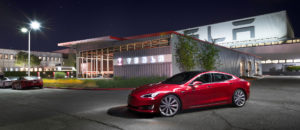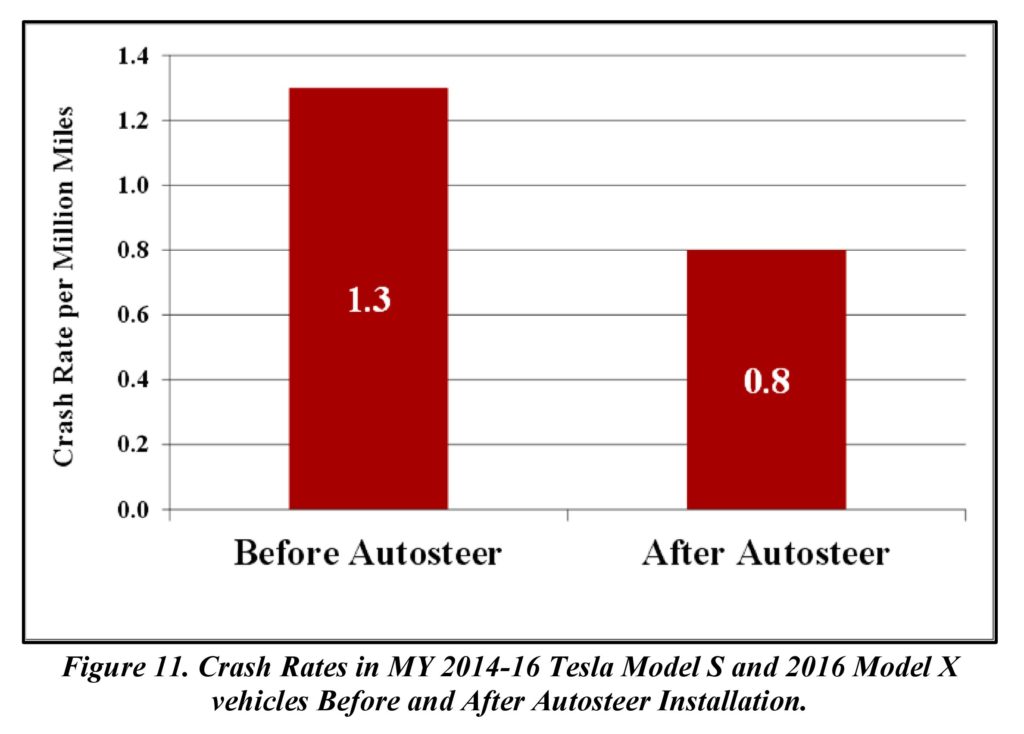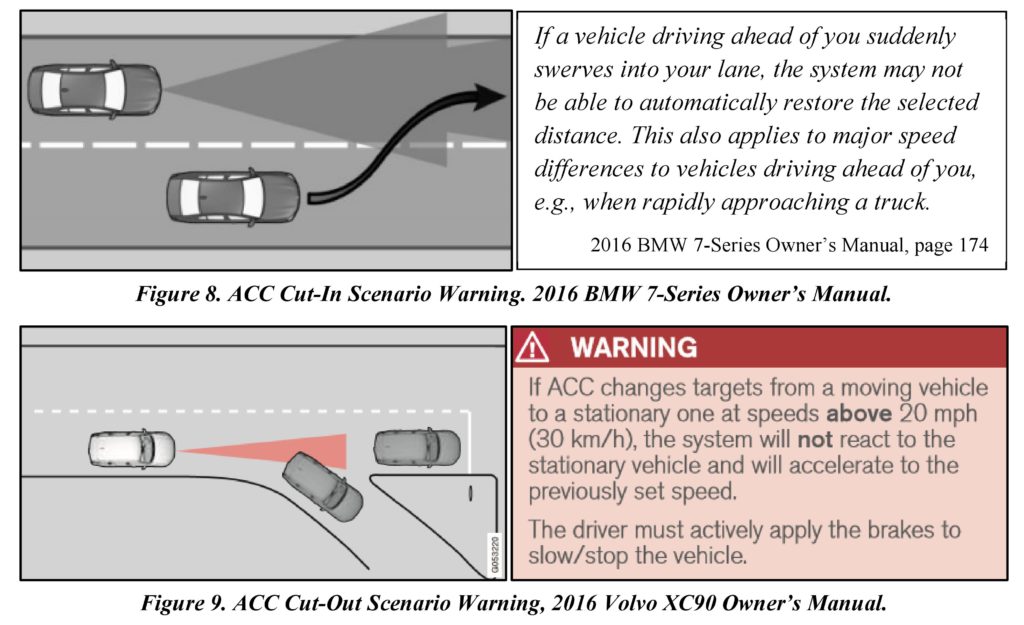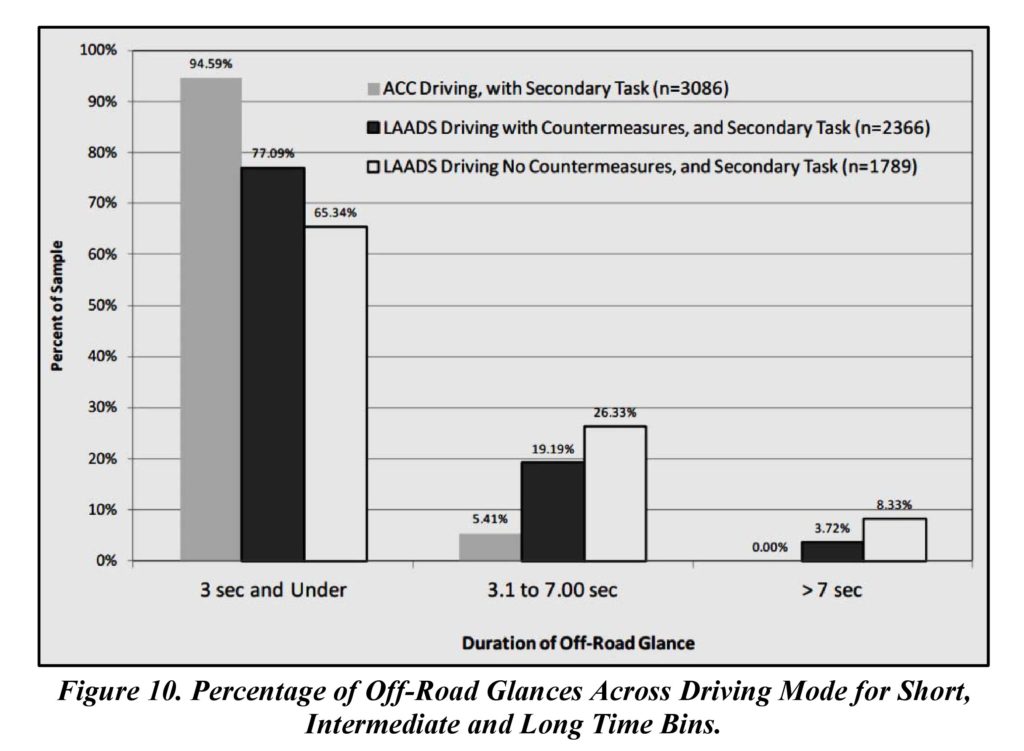
Goverment clears Tesla in Autopilot crash, notes Autosteer cars crashed 40% less
By onBusiness Practices | Education | Legal | Market Trends | Technology
The National Highway Transportation Safety Administration absolved Tesla of culpability in the death of a man whose Model S T-boned a tractor-trailer while in Autopilot mode.
The agency Thursday closed the inquiry, one of its last pieces of business under the Obama administration. While it does note the role driver inattentiveness seemed to play in the crash — a seemingly unshakable condition of human nature which has kept body shops in business for decades — the NTHSA also found that Tesla Autosteer also cut the OEM’s crash rate by 40 percent.
“ODI analyzed mileage and airbag deployment data supplied by Tesla for all MY 2014 through 2016 Model S and 2016 Model X vehicles equipped with the Autopilot Technology Package, either installed in the vehicle when sold or through an OTA update, to calculate crash rates by miles travelled prior to and after Autopilot installation,” the NTHSA wrote. “… The data show that the Tesla vehicles crash rate dropped by almost 40 percent after Autosteer installation.”
There are a couple of caveats, according to the NHTSA. Only a third of the Teslas studied had mileage before the Autopilot installation, and crash rates are general metrics for the car that don’t take into account whether Autopilot actually was being used.
But overall, it doesn’t look good for collision frequency going forward, considering we’re talking about technology that Tesla describes as still in beta and OEMs (see this Wired report) and researchers caution might still produce collisions from human-machine transition requirement.

Some of the crashes that did occur during or shortly after Autopilot mode were the fault of “other vehicles striking the Tesla from
various directions with little to no warning to the Tesla driver” and scenarios like “cut-ins, cut-outs and crossing path collisions,” the NHTSA wrote.
It provided examples from the 2016 BMW 7-Series and Volvo XC90 manuals illustrating the problems adaptive cruise control has with vehicles cutting quickly into a lane or out of one. According to the Volvo document, the real problem with a cut-out can be when the car in front of the exiting vehicle is stopped. At above 20 mph, Volvo cautions, the car doesn’t realize the latter isn’t moving and will plow into it.

The NHTSA found that the 2015 Tesla Model S in question was in Autopilot but neither the autobraking system or driver did anything to stop the crash with a tractor-trailer that was crossing a Florida intersection. However, it also found that none of the OEMs it contacted had autobraking systems designed to prevent crashes with perpendicular traffic, and its research a few years ago found the same gap in the system.
“The limited time the target is in the field of view prior to impact challenges the system’s ability to perform threat assessment and apply the CIB system. A target is usually recognized very late or not at all prior to impact,” a 2011 NHTSA study of cross-traffic autobraking states.
While investigating the Tesla crash, the NHTSA tried out a 2015 Tesla Model S 85D and Mercedes C300 4Matic, and found both autobraked enough to stop all crashes and even the adaptive cruise control “generally provided enough braking to achieve crash avoidance.” Neither vehicle could stop correctly for crossing traffic or someone turning left into their path.
But since Tesla had warned drivers to pay full attention and only use the car on dry, straight roads and not streets (though its own videos sort of contradict this) and taken steps before and after the crash to tell drivers to keep their hands on the wheel, the NHTSA absolved it in the crash.
Tesla sees if you’re paying attention by monitoring what’s done with the turn signal and adaptive cruise control and — with “microtorque measurements” — if your hands are on the steering wheel. Take the hands off the wheel too long, and the car nags you back into compliance and slows:
“The warnings start with a visual alert indicating that hands on the steering wheel are required. If the driver does not respond to the visual warning, an audible chime is sounded after 15 seconds. A more pronounced chime is initiated if the driver does not respond after another 10 seconds. If the driver fails to respond to the third alert stage within five seconds, the system gradually slows the vehicle while maintaining position in the lane. Once the driver’s hands are detected on the steering wheel, the warnings are suspended and Autopilot operation resumes.”
In September 2016, Tesla updated the software to produce an “Autopilot strikeout” — you’re cut off from using Autopilot during the rest of the drive — and to change the time between alerts.
The NHTSA says that OEMs must inform the driver of system limitations but also build in measures like the ones above to account for drivers who don’t read the manual or are otherwise inattentive.
In the Florida Tesla crash, the NTHSA concluded that the driver had about 7 seconds of reaction time to avoid the crash but did nothing.
The investigation found that most Tesla Autopilot crashes happened “in less than 3-4 seconds.”
“Distractions greater than seven seconds, such as appears to have occurred in the fatal Florida crash are uncommon, but foreseeable,” it continued.
GM produced an interesting 2012 study on this issue. On cars with just autobraking, it found drivers didn’t take their eyes off the road much more than 3 seconds or less. But when automatic braking was combined with “imperfect” lane centering, the proportion of motorists being distracted for longer than three seconds grew — and the cars which had “perfect” lane-centering and autobraking saw the highest proportions of distractions greater than 3 seconds.

That suggests that humans will be more complacent enough the better the tech gets. Research by Lextant found that humans need about 5-8 seconds to get their head in the game and assess the situation if they’re paying zero attention to driving and the car says to take over.
On the other hand, while the transition to more autonomous vehicles — and remember, autonomy doesn’t just mean Google cars but also “simple” tech like electronic stability control or autobraking — will apparently still produce crashes and possibly promote inattentiveness, the difference in Tesla crash rates still suggests that motorists will net still have fewer crashes with various ADAS tech installed. Plus, there’s the question of whether these Tesla drivers that didn’t notice cut-ins and cut-outs in less than 3 seconds would have fared any better or paid more attention were they driving a base-model car from the 1990s.
The investigation results can be found here. As government documents go, it’s actually a pretty short and clear-cut read, and body shops might want to take a look both for the ramifications on collision repair volume and the level of investigation into autonomous crashes. Service and repair wasn’t addressed in the Tesla report, but God forbid a similar investigation look at mechanical or auto body repair as a contributing factor in one of these high-profile incidents.
NHTSA, Jan. 19, 2016
Images:
A Tesla Model S is parked near Tesla’s Fremont headquarters. (Provided by Tesla)
The NTHSA found in a January 2017 report that Tesla Autosteer installation also seemed to cut the OEM’s crash rate by 40 percent. (Provided by NHTSA)
Examples from the 2016 BMW 7-Series and Volvo XC90 manuals illustrate the problems adaptive cruise control has with vehicles cutting quickly into a lane or out of one. (BMW and Volvo documents provided by NHTSA)
On cars with just autobraking, General Motors found drivers didn’t take their eyes off the road much more than 3 seconds or less, according to research published in 2012. But when automatic braking was combined with “imperfect” lane centering, the proportion of motorists being distracted for longer than three seconds grew — and the cars which had “perfect” lane-centering and autobraking saw the highest proportions of distractions greater than 3 seconds. (Copyright General Motors, provided by NTHSA)
